The first 18-holes of William P. "Billy" Bell's Sunset Fields "daily fee" course opened in September 1, 1927, at today's Martin Luther King and Crenshaw boulevard's! pic.twitter.com/ww15Rwn0md
— Golf Historical Society (@GolfHistorical) June 20, 2023
Category: William P. Bell
Coming to L.A. for the U.S. Open? George Thomas #1
The U.S.G.A.’s 24th Amateur Public Links Championship of 1949 Opened the Rancho Golf Course!
Willie Hunter and George Von Elm at Rancho Golf Club in 1923
Holmby Park Pony Golf Course by Billy Bell and Bill Johnson!
125 Years of Griffith Park. 107 Years of Golf
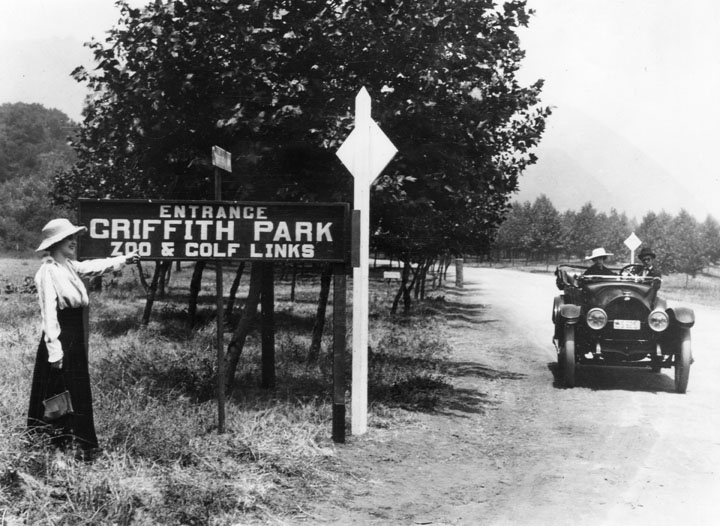
Griffith Park was donated to the city of Los Angeles by Griffith Jenkins Griffith and his wife Christina Mesmer Griffith at Christmas of 1896. This November 13 the Recreation and Parks Department are celebrating the 125th anniversary of that gift.
The first Griffith Park municipal golf course, No. 1, opened on November 1, 1914, with the support of members of the Los Angeles Country Club and the Southern California Golf Association. It was a sand green links designed by golf legend Tom Bendelow and was located under Wilson #1,2,18, and Harding #17 and 18, west of the old city water pipe.
The old links were much loved by the country club crowd. They were also the site of many a film star hitting balls between takes. Griffith Park was location #1 in the late teens! Many athletes, celebrities, and other sports stars visited Los Angeles in the winters. Babe Ruth even signed his Yankee contract while playing Municipal No. 1 in 1920.
In 1923 George C. Thomas Jr., designed new municipal, No. 2, Harding Memorial, and in 1927 the Wilson Memorial, both all-grass golf courses. Nine holes of the old sand course, which are now part of the Zoo, were kept, and grassed-over in the 1930’s, and renamed the Roosevelt Memorial Golf Course.
In the early 1930s, superintendent of golf, William Johnson, and architect William P. Bell, modernized the courses using Federal Works money, installing irrigation and building the current clubhouse by 1936. It replaced the English style field house of 1918. Both Wilson and Harding courses were used for the L.A. Opens of 1937-1939.
After the great flood of 1938, the L.A. River was channelized to protect the park from flood damage. The county road was built in the 1920s along the river bank, and their “right of way” became the battle over the 5 Freeway in the late 1950s. The golf holes along the county road were taken during construction, but the land was returned afterward, with new holes designed to replace them.
Later, Wilson lost three more holes that became the Crystal Springs picnic area. There is also an old par 3 that had been the 18th and then the 16th hole on Thomas’s Harding, located between the 1st and 17th holes, which was abandoned in the 1950s.
In the early 1960s the city of L.A. wanted a new Zoo, and decided to replace the old Roosevelt golf course. The uproar caused the construction of the new Roosevelt golf course in Vermont Canyon, which was built to replace the historic remnant of the original 1914 Municipal No. 1. Both courses were open on the same day in 1964, after which the turf grass from the old course was spread around the city’s other courses.
Griffith Park was also home to the Coolidge Memorial course, now called the Tregnan Academy, the Los Feliz driving range and Par 3 course, and the nine-hole putting course on the second floor of the Griffith Park Bath House.
Los Angeles Recreation and Parks should be very proud of their accomplishments, having turned the original 18-hole sand course into a golf system that today has twelve courses that have been funded by the receipts from Griffith Park and later Rancho Park.
Come out on the 13th of November and enjoy the beautiful gift of the park and all of the awesome facilities that we in Los Angeles are so proud to have!
©2021 jib jones – golfhistoricalsociety
Altadena Country Club – Pasadena Golf Club 1911-2021
William Watson of Pasadena, Chicago, and St. Andrews, Scotland, started designing the original Altadena Country Club in February 1911 for J. B. Coulston, president of the National Bank of Pasadena and owner of the Maryland Hotel.
Coulston headed a group of hotel men and other “capitalists,” who had sold their Pasadena Country Club to H.E. Huntington, and hoped to ease overcrowding on the Annandale and Hotel Raymond links by forming a land association and buying 134 acres of the old Allen Ranch in Altadena as a replacement. They named it the Altadena Country Club.
The new clubhouse, 6466 yard eighteen-hole sand-green golf course, and two cement tennis courts, opened on December 28, 1911. Unfortunately, a freak sandstorm in February of 1912 blew the roof off the clubhouse, sending furniture flying in all directions, and greatly damaged the golf course. The next year a three day rain storm flooded and nearly destroyed the course, sending debris into Pasadena. Urgent reconstruction of the Rubio Wash channel through the course to control flooding delayed Watson’s full restoration of the damage, so they built a temporary nine-hole course north of Mendocino Street.
The restoration work was finished at the end of 1914. Watson himself became professional in 1915, while continuing to manage the Hotel Huntington (Pasadena CC) course.
The Altadena Country Club joined the Southern California Golf Association (SCGA) in 1915, and entered SCGA Team play in 1916.
In 1920, J.B. Coulston and the California Hotel Company bought the Altadena Country Club, and planned $500,000 in improvements, with three eighteen-hole golf courses, and named it the Pasadena Golf Club.
In a break with William Watson, George O’Neil, “golf expert of Chicago,” (Toledo CC, Beverly CC), and of the Pasadena Country Club, who had laid out Annandale Golf Club with Arthur Rigby (Los Angeles CC, San Gabriel CC, Santa Anna CC, ) and Al Naylor (Hotel Green, Annandale GC, San Gabriel CC), was hired to layout the new courses. His assistant was Jack Croke, of Chicago’s Exmoor club. Croke built the new course with William P. Bell, who had previously been Caddiemaster, and then Ground Superintendent, at Annandale Golf Club.
The first nine-holes of the new Pasadena Golf Club opened on October 31, 1920, and the second nine in December. It was the first golf course in Southern California with real undulating grass greens. William P. Bell became Superintendent of Pasadena GC in 1921, and Bell and Jack Croke teamed up to rebuild the greens at Annandale in 1922, and at the new Rancho Golf Club in 1923.
The Pasadena Golf Club was taken over by the bank in 1932, renamed the Altadena Golf Club, and open to the public until 1945, when the land and buildings were sold to Westmount College. They were denied the right to build their school on the property, so they split it up and sold it, selling 60 acres of the golf course to Los Angeles County.
L.A. County reworked the remaining nine-holes of the 1920 course and the Altadena Golf Club opened for play in 1950, officially opening in 1951, and continues to be operated by L.A. County 110 years after it started.
©2021 jib jones – golfhistoricalsociety
The Warren G. Harding Memorial Golf Course turned 98 on August 11, 2021.
Harding Municipal Golf Course in Griffith Park, Los Angeles, opened on August 11, 1923, as Griffith Park Course No. 2. It was the first all-grass links in the park. A country club for the masses!
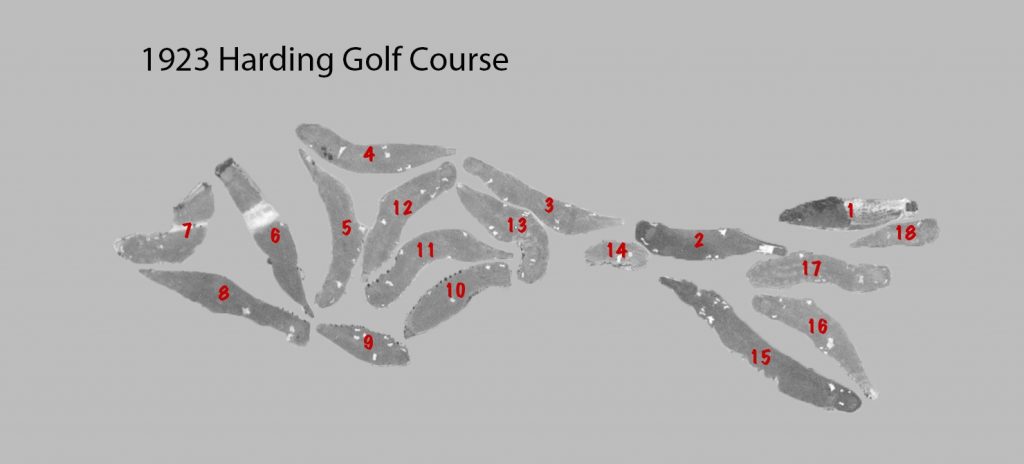
Name: Griffith Park Course No. 2, Warren G. Harding Memorial (renamed 1924)
Nickname: Riverside
Course: 18 Hole, all grass tees and greens.
Yards: 6423 yards
Par: 444444453 – 444435443 – 36 – 35 – 71
Open: August 11, 1923 – Postponed from August 4, due to the death of President Harding on August 3.
Green Fee: $1
Ten plus holes remain from the original 1923 layout.
Harding – 1,2,3,5,6,14,16, (4, tee, fairway – 1923 H13)
Wilson – 5,6,13 (10, tee, fairway – 1923 H10)
Architect: George C. Thomas Jr.
Construction Committee: chair. Edward B. Tufts (SCGA, CGA, LACC), Mrs. Ann Trabue (chair. Golf Advisory Board)
Assistants: Max Behr, William P. Bell
Superintendent: Carl Worthen
Professional: S.C.P.G.A. sec. J.A. “Pat” Patterson (absent – at National Open)
Park Commission: Pres., Mrs. Martha McCann, master of ceremonies
City of L.A.: Councilman Ralph Criswell (filling in for Mayor Cryer) accepted the new course from Ed Tufts.
Opening Exhibition Matches – 1 PM
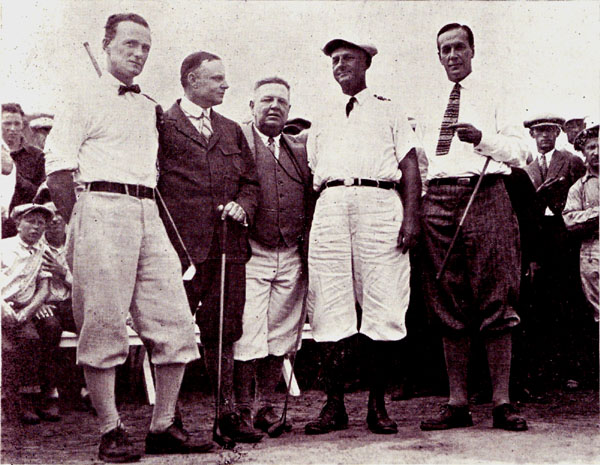
The designer of the course, George C. Thomas Jr., drove the first ball in an amateur foursome. He was paired with Southern California and British Amateur champion, Willie Hunter, playing against Wilshire CC’s, Norman Macbeth and Annandale’s A.D.S. Johnston. Hunter and Thomas won the 18 hole match, 1 up.
The amateurs were followed by a foursome of professionals led by LACC’s Vic Dalberto and ex-LACC and Open champion Hutt Martin, who won their match, 3 up 2 to play, from Midwick Country Club’s Chick Fraser and Pasadena Golf Club’s Mel Smith.
The following day the course was open to the public for $1 green fee. Over 400 golfers played Course No. 2 (Harding), and 250 played the old No. 1 sand-green links.
What a gift they gave us!
©2021 jib jones – golfhistoricalsociety
The Opening of Los Angeles Country Club’s W. Herbert Fowler designed North course in 1921
It was with great anticipation that Los Angeles Country Club’s new North course at Beverly officially opened to members on Wednesday, August 10, 1921, making LA CC the first club in California to have adjoining eighteen hole golf courses. The new course had been “thrown open for practice,” in early June, and members had declared it couldn’t be improved.
The big event of the opening day was an exhibition match between green committee man, George C. Thomas Jr., who laid out the W. Herbert Fowler designed eighteen hole golf course, paired with Miss Doreen Kavanagh, Southern California and State amateur champion, playing against Southern California amateur champion and general manager of Catalina Island Company, Everett Seaver, and Northern California women’s champion, Miss Margaret Cameron.
Thomas and Kavanagh defeated Cameron and Seaver by a score of 3 up and 3 to play. Broken down, Thomas beat Seaver, 1 up, and Kavanagh beat Cameron 3 and 2, in what was called a keen match.
After the exhibition there was a dinner and dancing for 400. The day’s events were filmed.
The club’s Superintendent of Grounds for many years was Charles Cavanaugh. He and his crew did an amazing job building and rebuilding holes for both new golf courses in under a year, all while keeping 18 holes open for competition.
Alex J. Morrison, of Los Angeles Municipal, Catalina Island, and vaudeville, who had started at LACC as a caddy at Pico and Western, was appointed professional in July of 1921, replacing golf legend John Duncan Dunn and his team of British golfers. Morrison’s assistants were Vic Dalberto and Harry McNamara. Alex was soon back on stage and replaced at LACC by Alex Duncan, brother of earlier LACC professional James Duncan, and British golf legend George Duncan.
There was so much praise heaped on George C. Thomas Jr., for laying out the North course, that Herbert Fowler got more than a bit lost in the press releases. Fowler was a very busy man that summer, having completed the South and North courses for LA CC, the Ambassador-Rancho Golf Club, redesigns of Del Monte #1 and #2 (Pebble Beach), and designs for the Presidio, Olympic Club, Burlingame, Crystal Springs and others.
The North course still has 12-13 original holes laid out by Fowler that were reconstructed by William P. Bell to George C. Thomas Jr.’s redesign in 1928, when they also added five new holes. The 2010 Gil Hanse restoration was to the 1928 Fowler-Thomas-Bell version of the North, plus rebuilding the old Fowler par three 17th (replaced in 1928), which is now an extra hole.
On August 10, 2021, we can celebrate the design brilliance of Herbert Fowler, George C. Thomas Jr., and William P. Bell, along with the restoration by Gil Hanse. Happy 100th Birthday LA CC North!
©2021 J.I.B. Jones -golfhistoricalsociety.org
Tiger Pines – the 2008 U.S. Open
by J.I.B. Jones
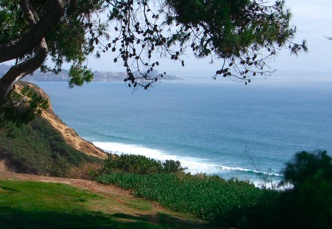
In mid-June 2008 I took the Pacific Surfliner train along the coast from Los Angeles to Rancho Santa Fe and thence to Torrey Pines for the 108th U.S. Open golf championship. I was a guest of the U.S.G.A. after having helped Pete Georgiady research for his article about public golf on the west coast in the official 2008 U.S. Open Program. Pete’s story opened with my story of baseball legend Babe Ruth signing his Yankee contract at Griffith Park’s original 18-hole Municipal Links in January 1920. Griffith Park later hosted the Los Angeles Open from 1937-1939 on both George C. Thomas Jr., designed courses. They were remodeled and toughened up in the 1930’s by Billy Bell and Bill Johnson with Works Progress Administration funding in anticipation.
Los Angeles’s other municipal gem is the Rancho golf course where the Open was also held from 1955-1972, and in 1983 when the Riviera Country Club held the P.G.A. championship. Rancho’s most memorable moment, as chosen by the editors, was Arnold Palmer’s 12 during the first round of the 1961 L.A. Open. Nevertheless, I’m more than pleased to have my name in print as the Rancho Park Golf Club historian. Thanks to everybody in the club for being a part of it, and to L.A.’s Recreation & Parks Golf Division for recommending me to Pete!
As I was lucky enough to be staying in Rancho Santa Fe with a great friend, I was able to take the volunteer shuttle from the polo grounds to Torrey Pines all week with no hassle. The U.S.G.A.’s organization was spectacular, and no matter what the armchair golf architects think about Torrey Pines’ value as a golf course, Riviera could never host a US Open without a second course for practice and staging and large crowds of spectators. Well, I guess they could if they closed Brentwood, and maybe Bel-Air, and filled them with tents, and shuttled people by helicopter like they do at Grand Prix races!
Unfortunately, the U.S.G.A. didn’t have time to do any historical research on Torrey Pines. In fact, in their display of future US Open venues — in the American Express tent — they wrongly credited Chandler Egan with changing the 18th at Pebble Beach into a par 5. We at Rancho, and Neal Hotelling (the official historian of Pebble Beach), know that it was LACC and Rancho’s own W. Herbert Fowler who made the changes in 1921, the same year he finished designing the original Rancho-Ambassador course, and the Los Angeles Country Club’s North and South courses.
As is my custom, I told everyone that I met about Torrey’s history, even though they were mostly interested in a certain golfer from Cypress, California…
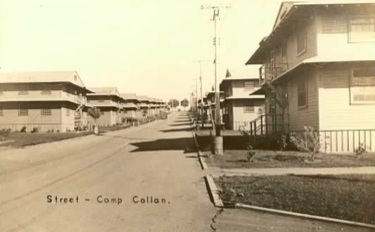
Camp Callan – Torrey Pines South during WW II
For the record, Torrey Pines was given to San Diego in 1908 by Ellen Scripps, the most amazing philanthropist California has ever known. Miss Scripps, along with her sister Virginia, bought every acre of Torrey Pines to stop development, and then donated it to the City of San Diego to be protected and used as a public park. During World War II it became Camp Callan, the Coast Artillery Corps base, then a Sports Car Club of America race track, and then finally the Torrey Pines golf courses.
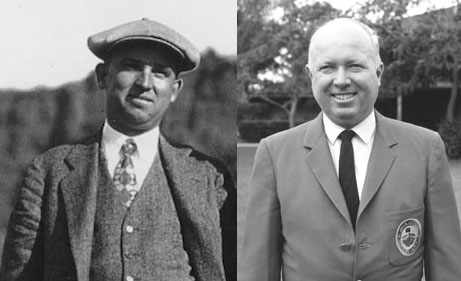
Billy Bell and his son Billy Jr.
William P. “Billy” Bell, who designed, co-designed, or constructed the majority of the great Southern California golden era golf courses before his untimely death from a heart attack in 1953, had the original vision for Torrey Pines. His equally prolific and brilliant son William F. Bell (Billy Jr.) made his father’s vision a reality by completing the designs in 1955 when he began construction of the golf courses.
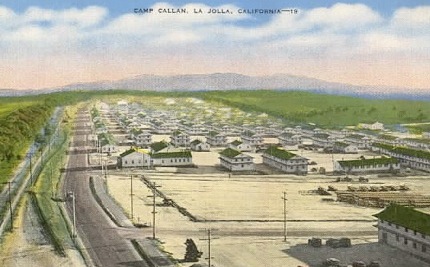
Camp Callan postcard – Torrey Pines South during WW II
Billy Jr. shaped the mostly flat landscape into the rolling land of the Torrey Pines we know today by using the many acres of asphalt roads, parade grounds, and even the foundations of the camp buildings, piling the rubble to shape the courses. Truly a pair of genius’ at work!
Torrey Pines South course opened in June 1957 with an exhibition that included 1934 Rancho golf course professional Ralph Guldahl, winner of the 1937-38 U.S. Open and the 1939 Masters.
In 1972 golf course architects David Rainville and Billy Casper did a major remodeling job which included recontouring the greens. More recently, Rees Jones improved the layout tenfold in preparation for the 2008 US Open. The local club golfers I met over the week were amazed at how beautiful Rees had made their golf course.
Maybe we can use Hillcrest for the extra tents and host the US Open in 2024 at Rancho Park!
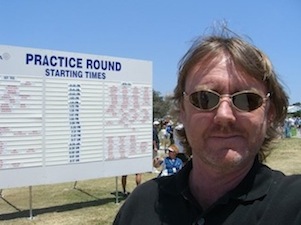
Jones during U.S. Open practice at Torrey Pines
Back to the 108th US Open.
The rough during the practice rounds was all anybody needed to see to know that hitting fairways was going to be the name of the game at this Open. Unlike the Masters, getting up and down wasn’t the hard part. Narrow fairways made it paramount to be in the fairway. Even the short rough made hitting the green unlikely and a bogey likely. Many players also seemed to be caught off guard by the fluffy sand traps and the slowness of the greens the first couple of days compared to expectations.
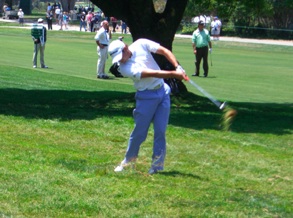
Sergio Garcia didn’t get this one (or the next 2) out of the second cut on 14 on Wednesday.
The U.S.G.A.’s scoring prediction was right on. They got what they wanted and the spectators and TV viewers were treated to some brilliant golf. Even the best drivers of the ball ended up in the rough and paid the price. How Tiger won while missing so many fairways says volumes about the quality of his short game and his superhuman strength from the rough. Even though we always go on about his awe-inspiring swing, he really is also as good as the best putter who has ever lived — and his ‘drive’ to win is unequalled.
There were many highlights of my week, including seeing former S.C.G.A. President Ed Holmes scouting the course for the TV announcers, and meeting up with legendary golf course supervisor Ted Horton (C.G.C.O.A.), Kevin Heaney (S.C.G.A.), Craig Kessler (P.L.G.A.) and U.S.G.A. President Jim Vernon and his assistant Ashleigh on the North Course, away from the action, for a photo shoot celebrating Golf Week in California.
The most impressive feat of the event, without a doubt, were the thousands of volunteers who came from all over America and across the world to work for their clubs and charities, helping to raise millions for their communities. It really is the pinnacle of dedication and charitable giving by the volunteers, and the U.S.G.A. should be praised for using their championships this way.
I was so lucky to have been a part of the 108th US Open. Thank’s Pete and Kevin! I did it wearing my Rancho Park logos in full view on the various shirts and visors I wore all week.
Next up for us in California – Pebble Beach 2010.
All photos and words Copyright 2008-2014 JIB Jones Golf Historical Society
Not to be reprinted without permission.
